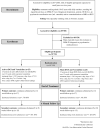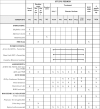Active versus sham transcranial direct current stimulation (tDCS) as an adjunct to varenicline treatment for smoking cessation: Study protocol for a double-blind single dummy randomized controlled trial
- PMID: 36480510
- PMCID: PMC9731486
- DOI: 10.1371/journal.pone.0277408
Active versus sham transcranial direct current stimulation (tDCS) as an adjunct to varenicline treatment for smoking cessation: Study protocol for a double-blind single dummy randomized controlled trial
Erratum in
-
Correction: Active versus sham transcranial direct current stimulation (tDCS) as an adjunct to varenicline treatment for smoking cessation: Study protocol for a double-blind single dummy randomized controlled trial.PLoS One. 2025 Jan 30;20(1):e0318721. doi: 10.1371/journal.pone.0318721. eCollection 2025. PLoS One. 2025. PMID: 39883684 Free PMC article.
Abstract
Background: Smoking is a chronic and relapsing disease, with up to 60% of quitters relapsing within the first year. Transcranial Direct Current Stimulation (tDCS), targets cortical circuits and acutely reduces craving and withdrawal symptoms among cigarette smokers. However, the efficacy of tDCS as an adjunct to standard smoking cessation treatments has not been studied. This study aims to investigate the effectiveness of tDCS in combination with varenicline for smoking cessation. We hypothesize that active tDCS combined with varenicline will improve cessation outcomes compared to sham tDCS combined with varenicline.
Methods: This is a double-blind, sham-controlled randomized clinical trial where fifty healthy smokers will be recruited in Toronto, Canada. Participants will be randomized 1:1 to either active tDCS (20 minutes at 2 mA) or sham tDCS (30 seconds at 2 mA, 19 minutes at 0 mA) for 10 daily sessions (2 weeks) plus 5 follow up sessions, occurring every two weeks for 10 weeks. All participants will be given standard varenicline treatment concurrently for the 12-week treatment period. The primary outcome is 30 day continuous abstinence at end of treatment, confirmed with urinary cotinine. Measurements made at each study visit include expired carbon monoxide, self-reported craving and withdrawal. Three magnetic resonance imaging (MRI) scans will be conducted: two at baseline and one at end of treatment, to assess any functional or structural changes following treatment.
Discussion: For every two smokers who quit, one life is saved from a tobacco-related mortality. Therefore, it is important to develop new and more effective treatment approaches that can improve and maintain long-term abstinence, in order to decrease the prevalence of tobacco-related deaths and disease. Furthermore, the addition of longitudinal neuroimaging can shed light on neural circuitry changes that might occur as a result of brain stimulation, furthering our understanding of tDCS in addiction treatment.
Trial registration: This trial has been registered with Clinicaltrials.gov: NCT03841292 since February 15th 2019 (https://clinicaltrials.gov/ct2/show/NCT03841292)-retrospectively registered.
Copyright: © 2022 Zawertailo et al. This is an open access article distributed under the terms of the Creative Commons Attribution License, which permits unrestricted use, distribution, and reproduction in any medium, provided the original author and source are credited.
Conflict of interest statement
All authors have completed the ICMJE uniform disclosure form at www.icmje.org/coi_disclosure.pdf and declare: no support from any organisation for the submitted work. PS reports receiving funding and/or honoraria from Pfizer Inc./Canada, Shoppers Drug Mart, Bhasin Consulting Fund Inc., Patient-Centered Outcomes Research Institute, ABBVie, and Bristol-Myers Squibb; LZ receives support from Pfizer Global Research Awards For Nicotine Dependence (GRAND) Award Program; there are no other relationships or activities that could appear to have influenced the submitted work. This does not alter our adherence to PLOS ONE policies on sharing data and materials. HZ and NR have no conflicts of interests to declare.
Figures




Similar articles
-
Efficacy of insula deep repetitive transcranial magnetic stimulation combined with varenicline for smoking cessation: A randomized, double-blind, sham controlled trial.Brain Stimul. 2023 Sep-Oct;16(5):1501-1509. doi: 10.1016/j.brs.2023.10.002. Epub 2023 Oct 6. Brain Stimul. 2023. PMID: 37806524 Clinical Trial.
-
Insula deep rTMS and varenicline for smoking cessation: A randomized control trial study protocol.Front Pharmacol. 2022 Sep 8;13:969500. doi: 10.3389/fphar.2022.969500. eCollection 2022. Front Pharmacol. 2022. PMID: 36160428 Free PMC article.
-
Lack of effect of transcranial direct current stimulation (tDCS) on short-term smoking cessation: Results of a randomized, sham-controlled clinical trial.Drug Alcohol Depend. 2019 Jan 1;194:244-251. doi: 10.1016/j.drugalcdep.2018.10.016. Epub 2018 Nov 13. Drug Alcohol Depend. 2019. PMID: 30497056 Free PMC article. Clinical Trial.
-
Antidepressants for smoking cessation.Cochrane Database Syst Rev. 2020 Apr 22;4(4):CD000031. doi: 10.1002/14651858.CD000031.pub5. Cochrane Database Syst Rev. 2020. Update in: Cochrane Database Syst Rev. 2023 May 24;5:CD000031. doi: 10.1002/14651858.CD000031.pub6. PMID: 32319681 Free PMC article. Updated.
-
Interventions for waterpipe smoking cessation.Cochrane Database Syst Rev. 2023 Jun 7;6(6):CD005549. doi: 10.1002/14651858.CD005549.pub4. Cochrane Database Syst Rev. 2023. PMID: 37286509 Free PMC article. Review.
Cited by
-
Correction: Active versus sham transcranial direct current stimulation (tDCS) as an adjunct to varenicline treatment for smoking cessation: Study protocol for a double-blind single dummy randomized controlled trial.PLoS One. 2025 Jan 30;20(1):e0318721. doi: 10.1371/journal.pone.0318721. eCollection 2025. PLoS One. 2025. PMID: 39883684 Free PMC article.
References
-
- Statistics-Canada. Current smoking trends. Report 2011.
-
- Gonzales D, Rennard SI, Nides M, Oncken C, Azoulay S, Billing CB, et al.. Varenicline, an alpha4beta2 nicotinic acetylcholine receptor partial agonist, vs sustained-release bupropion and placebo for smoking cessation: a randomized controlled trial. JAMA. 2006;296(1):47–55. doi: 10.1001/jama.296.1.47 - DOI - PubMed
-
- Jorenby DE, Hays JT, Rigotti NA, Azoulay S, Watsky EJ, Williams KE, et al.. Efficacy of varenicline, an alpha4beta2 nicotinic acetylcholine receptor partial agonist, vs placebo or sustained-release bupropion for smoking cessation: a randomized controlled trial. JAMA. 2006;296(1):56–63. doi: 10.1001/jama.296.1.56 - DOI - PubMed
Publication types
MeSH terms
Substances
Associated data
LinkOut - more resources
Full Text Sources
Medical

